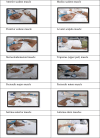Effect of muscle energy technique on pain, importance of physical activity, self-confidence, and posture in COPD patients with chronic neck pain: An experimental randomized controlled study
- PMID: 40550078
- PMCID: PMC12187307
- DOI: 10.1097/MD.0000000000042849
Effect of muscle energy technique on pain, importance of physical activity, self-confidence, and posture in COPD patients with chronic neck pain: An experimental randomized controlled study
Abstract
Background: Excessive use of accessory respiratory muscles leads to postural abnormalities and pain in the cervical area in patients with chronic obstructive pulmonary disease (COPD). This study aimed to evaluate the effects of the muscle energy technique (MET) on pain, importance of physical activity (PA), self-confidence, and posture in patients with moderate COPD and chronic neck pain.
Methods: This study is a randomized controlled parallel-group trial with an experimental design that includes a longitudinal follow-up process. This study included 52 COPD patients (26 in the MET group) (mean forced expiratory volume in one second [FEV1%: 63.53 ± 9.33] and 26 in the control group [CG] [FEV1%: 64.06 ± 8.53]). The MET group received MET 3/week for 4 weeks. Both groups participated in a home-based exercise program. Pain intensity (visual analog scale), importance of PA (importance scale), self-confidence (confidence scale), and posture (New York Posture Rating Chart) of all individuals were evaluated before and after the 4-week treatment period, as well as at the end of the 6-week follow-up period.
Results: Significant improvements were observed in both groups (P < .05). However, while a notable reduction in pain intensity was observed in the intervention group, significantly greater improvements were recorded in the perception of the importance of exercise, self-confidence in exercising, and postural alignment (P < .05). At week 4, pain data for both groups (resting, activity, and night pain scores, respectively) were as follows: low level pain (MET group: 25 ± 96.2, 26 ± 61.9, 26 ± 100.0; CG: 13 ± 50, 16 ± 38.1, 16 ± 61.5) and moderate level pain (MET group: 1 ± 3.8, 0, 0; CG: 13 ± 50, 10 ± 100.0, 10 ± 38.5). Additionally, the effects on the perception of exercise importance, self-confidence, and posture were maintained during the follow-up period (P < .05).
Conclusion: MET performed on the accessory respiratory muscles improved pain intensity and the importance of PA, confidence, and posture. MET was found to provide superior responses compared to the control group. Therefore, MET should be included as an important part of treatment programs for COPD patients with chronic neck pain.
Trial registration: ClinicalTrials.gov NCT04874571.
Keywords: COPD; muscle energy technique; physical activity; posture; self-confidence.
Copyright © 2025 the Author(s). Published by Wolters Kluwer Health, Inc.
Conflict of interest statement
The authors have no funding and conflicts of interest to disclose.
Similar articles
-
Physical activity and exercise for chronic pain in adults: an overview of Cochrane Reviews.Cochrane Database Syst Rev. 2017 Apr 24;4(4):CD011279. doi: 10.1002/14651858.CD011279.pub3. Cochrane Database Syst Rev. 2017. PMID: 28436583 Free PMC article.
-
Pulmonary rehabilitation for chronic obstructive pulmonary disease.Cochrane Database Syst Rev. 2015 Feb 23;2015(2):CD003793. doi: 10.1002/14651858.CD003793.pub3. Cochrane Database Syst Rev. 2015. PMID: 25705944 Free PMC article.
-
Physical activity and exercise for chronic pain in adults: an overview of Cochrane Reviews.Cochrane Database Syst Rev. 2017 Jan 14;1(1):CD011279. doi: 10.1002/14651858.CD011279.pub2. Cochrane Database Syst Rev. 2017. Update in: Cochrane Database Syst Rev. 2017 Apr 24;4:CD011279. doi: 10.1002/14651858.CD011279.pub3. PMID: 28087891 Free PMC article. Updated.
-
Computer and mobile technology interventions for self-management in chronic obstructive pulmonary disease.Cochrane Database Syst Rev. 2017 May 23;5(5):CD011425. doi: 10.1002/14651858.CD011425.pub2. Cochrane Database Syst Rev. 2017. PMID: 28535331 Free PMC article.
-
Physical exercise training interventions for children and young adults during and after treatment for childhood cancer.Cochrane Database Syst Rev. 2013 Apr 30;(4):CD008796. doi: 10.1002/14651858.CD008796.pub2. Cochrane Database Syst Rev. 2013. Update in: Cochrane Database Syst Rev. 2016 Mar 31;3:CD008796. doi: 10.1002/14651858.CD008796.pub3. PMID: 23633361 Updated.
References
-
- Lee AL, Goldstein RS, Chan C, Rhim M, Zabjek K, Brooks D. Postural deviations in individuals with chronic obstructive pulmonary disease (COPD). Can J Respir Critical Care Sleep Med. 2018;2:61–8.
-
- Yilmaz A, Ünal A, Atalay OT, Altuğ F, Ergur GA. Evaluation of neck pain in patients with chronic obstructive pulmonary disease. Mehmet Akif Ersoy Univ J Health Sci Inst. 2022;10:151–60.
-
- Borge CR, Wahl AK, Moum T. Pain and quality of life with chronic obstructive pulmonary disease. Heart Lung. 2011;40:e90–101. - PubMed
Publication types
MeSH terms
Associated data
LinkOut - more resources
Full Text Sources
Medical
Miscellaneous


